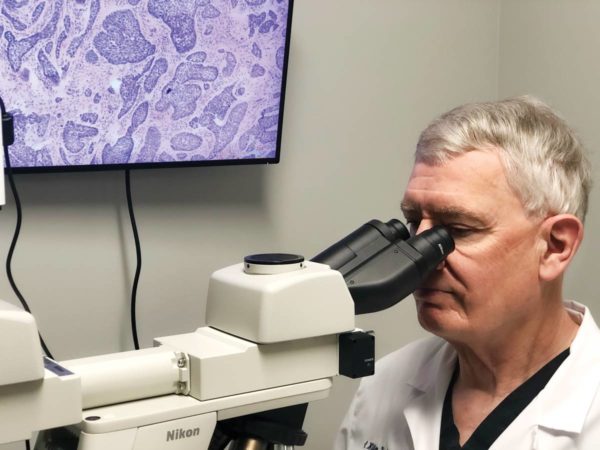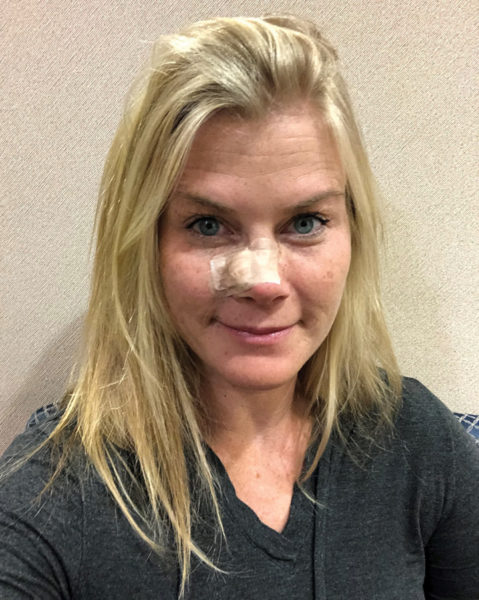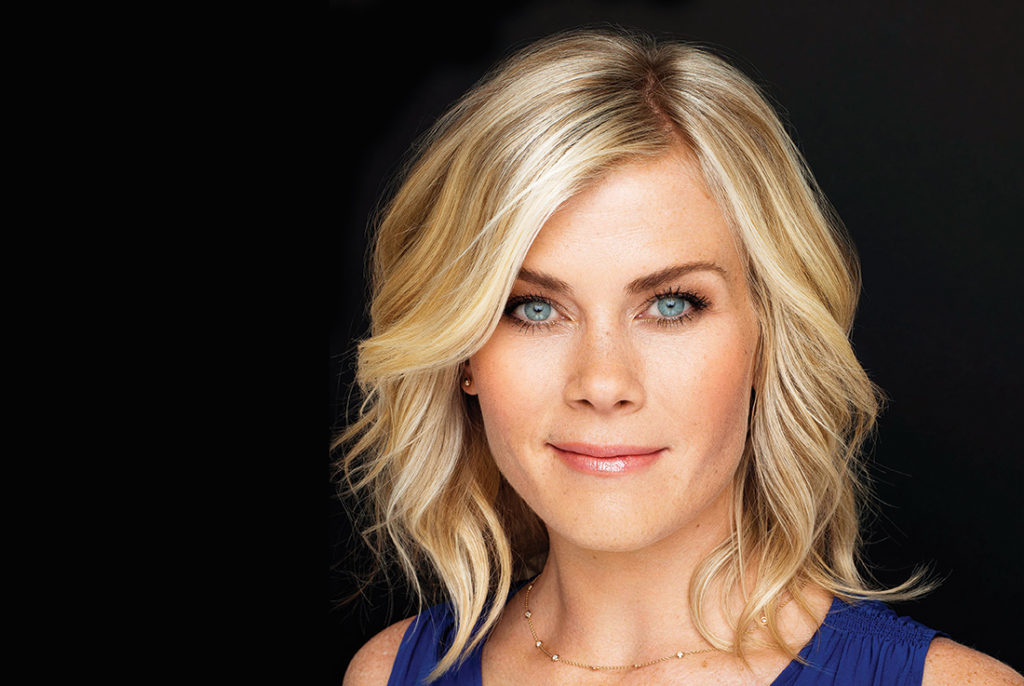Before BCC: Alison Sweeney’s fair skin and athletic outdoor lifestyle growing up in California put her at risk for skin cancer. When the busy actress was diagnosed, she thought, What’s the hurry? She’s glad she didn’t wait. Photo credit: Andrew Eccles
By Leslie Laurence
FACT: Basal cell carcinoma (BCC) is the most common skin cancer, with an estimated 3.6 million diagnosed in the U.S. each year.
FACT: Skin cancer anywhere on your skin can be scary, but especially around your eyes, nose and mouth.
FACT: While many BCCs are easily treated and cured, some can hide below the surface and cause more trouble than you might expect.
FACT: Even actresses like Alison Sweeney (above) get skin cancer and, as she learned, BCC can be a big deal!
Actress and producer Alison Sweeney is no stranger to drama. For decades, she portrayed treacherous troublemaker and master manipulator Sami Brady on the daytime drama Days of Our Lives, where fans cherished her as “the girl you love to hate.” More recently, she has solved murders and other nefarious crimes as podcast host Alex McPherson on The Chronicle Mysteries and as small-town baker Hannah Swensen on Murder, She Baked, both from Hallmark Movies and Mysteries.
Off-screen, Sweeney lives a more tranquil life with her husband, David Sanov, a California highway patrol officer, their children Ben, 15, and Megan, 11, and their dog, Basil, a Dalmatian-terrier-poodle mix they rescued during the Covid-19 pandemic — and who boasts more than 1,200 followers on Instagram (@official.basil.sweeney).
Sometimes, however, life imitates art, which is what happened to Sweeney when a July 2019 diagnosis of basal cell carcinoma (BCC) brought the drama too close for comfort. The actress, who hosted 13 seasons of NBC’s The Biggest Loser and has published five books (including three novels), spoke about her ordeal with The Skin Cancer Foundation in the hopes that her experience would encourage others to be diligent about sun protection and early detection.
I jumped at the chance to interview Sweeney. Not only did I have fond memories of her from her soap days, but in July 2020, I’d had surgery for a BCC on my nose, dead center just below the bridge. I was eager to compare notes. I especially wanted to know if Sweeney was as freaked out as I was about having a skin cancer on her face.
This may sound like a trivial concern given the context. After all, we’re talking about cancer. Shouldn’t the focus be on getting it out? End of story? Well, sure. But BCC is the most common skin cancer, and many of these tumors appear on the face, especially on the nose, where Sweeney’s was located as well. I wanted to be candid and not just talk about what it’s like to go through this, but also share “let’s be real” photos of our recoveries. Because, ultimately, whether or not you’re in the public eye, knowing you’ll have a scar on your face, albeit temporarily, can do a number on your self-esteem. If you are in front of audiences, the prospect of a deformity on your face can threaten your career.
As Sweeney learned, and as I learned, this can be a big deal.
Before I proceed, the good news. Medical science has made progress in the treatment of BCC, particularly for advanced disease. Mohs micrographic surgery, the gold standard for removing certain skin cancers while preserving the greatest amount of healthy tissue, can lead to spectacular cosmetic results. And postoperative laser and dermabrasion treatments can improve or nearly erase stubborn scars.
“What’s That on Your Face, Ali?”
Born and raised in Los Angeles, Sweeney and her two older siblings enjoyed a quintessential Southern California lifestyle. She recalls spending countless days swimming and horseback riding, running marathons and triathlons. She is also an avid gardener and hiker. All of that amounts to a lot of time in the sun. “You can’t stay out of the sun in Los Angeles,” she said. “It’s just not possible.”
Because she is fair-skinned and freckles easily, Sweeney always followed her mother’s lead, vigilantly applying sunscreen and wearing hats to shield her face from the rays. As an adult, she saw her dermatologist for regular skin checks, even before her father was diagnosed with advanced BCC in the early 2000s. Sweeney thought she was doing everything right — and then, during a routine skin check, her dermatologist asked the dreaded question, “What’s that on your nose, Ali?”
“I think it’s just a pimple I keep picking at,” Sweeney said.
Her dermatologist replied, “I don’t think that’s a pimple.” Sweeney felt her breath quicken as the doctor took a sample of the lesion to send to the lab for a biopsy.
What Sweeney had thought was a harmless blemish on the flare of her right nostril was, in fact, a BCC. Her initial reaction? Well, it’s just skin cancer, she thought. I’m not dying. “You try to tell yourself it’s no big deal.”
C. William Hanke, MD, founder of the Laser and Skin Surgery Center of Indiana and a senior vice president of The Skin Cancer Foundation, sympathizes but has another perspective. “Well, it depends on your definition of a big deal,” he says. It’s true that many BCCs are caught early, when the cure rate is high. However, he cautions, “The lesion you see on your skin is like the tip of an iceberg. Basal cell carcinomas have microscopic fingers of tumor that continue to grow and can become great big icebergs under the surface.
“These cancers can destroy parts of your face. Sometimes we have to take off part of a person’s nose or ear. Sometimes it affects the upper or lower lip. So even when they’re curable, BCCs can do a lot of damage.” Some BCCs may recur. A small percentage become advanced, and while it is extremely rare, a few metastasize and become life-threatening. Sweeney was glad to know hers was caught early.

“The beauty of Mohs surgery is that it removes all the cancer and leaves the maximum of normal tissue to use for the repair work,” says Dr. Hanke (above). “You end up with much better cosmetic results.” Photo: Courtesy of C. William Hanke, MD
Still, as is often the case, Sweeney’s diagnosis came at an inopportune time. She and her family were about to travel for the Fourth of July holiday. She wanted to put the surgery off until after her vacation, but her dermatologist advised her not to wait. In fact, the doctor wanted to schedule Sweeney for Mohs surgery as soon as possible. “I’m telling you, this is not a joke,” the dermatologist said.
Sweeney’s reaction? “I wondered why she was making such a big deal out of this.” For her part, Sweeney was having a hard time committing to the surgery. “I’m in an industry where people are judgy. Like, ‘Oh, she had her nose worked on.’ I was worried about my face and what I would look like after. I just had all these superficial, very ridiculous concerns in my mind and because the cancer was so small, I thought, Is surgery really worth it? Am I opening up a can of worms? “Both my dermatologist and a specialist said to me, ‘You have to find out what’s in there.’”
The Waiting Game
Mohs is a very precise surgery performed by dermatologic surgeons who are specifically trained to remove layers of tissue in what are called stages. Each stage involves one or more frozen sections that are examined under a microscope. If there are any cancerous cells in the tissue margins, the surgeon takes another layer precisely where the cancerous cells have been pinpointed and repeats the process until the margins are cancer-free.
Each stage can take an hour or more, but much of the work happens behind the scenes in the lab. The bulk of a patient’s time is spent waiting. Sweeney understood the process but was sanguine that hers would be one stage and done; after all, her lesion was small, and she’d only had it a few weeks.
After the first stage, she sat in the waiting room taking in an episode of The Crown on her iPad. She also started to live-post about her Mohs surgery on Instagram (@alisweeney), sharing photos of her numb, bandaged face. “I talk a lot about sunscreen and sun safety anyway,” she told me. “It made sense that I’d talk about this. I also was aware that people are always looking for an opportunity to have a conspiracy theory about you if you’re an actor. Like, if I have a bad bruise or bandages on my face, people will have some story to tell about what it is. ‘Did she have work done?’ I wanted to control my narrative.”
After her second stage, she thought about her father, who had been slightly disfigured from BCC. She consoled herself by remembering that his lesion had gone undiagnosed for about a decade. Hers had certainly been caught early.
As she waited for the results of the third stage, she realized, “This could be more than I anticipated. At that point, I was really scared.” By the fourth stage, she felt her anxiety level rise. “They say actors’ faces are very symmetrical. Mine happens to be a very symmetrical face, so I’m thinking, You’re gouging out who knows how much of my nose! “You go into this not knowing where the end is.”
Would there be a fifth stage? Would she lose part of her nose? Would she have to come back the next day for more work?

Mohs Nose: Sweeney’s tumor looked small on the outside, but its roots ran deep. By the third stage of her Mohs surgery, she was scared how it might affect her face as an actress. By the fourth stage, she was just grateful she had surgery when she did. Photo credit: Courtesy of Alison Sweeney
What’s Under That Bandage?
Late that afternoon, Sweeney received word that the fourth stage of her Mohs surgery had done the trick: Her margins were clear. But she was shocked when her surgeon told her that the tumor was so deep, it nearly pierced her nostril. She’d been harboring an iceberg! As the doctor explained how he would move and suture the skin to produce the best cosmetic result, Sweeney braced herself for the worst. What if this does change the shape of my nose? she thought. What if I don’t look like myself anymore?
I could relate to her fears. Although the surgery to remove my BCC required only one stage, I was fixated on my future scar: How big would it be? How long would it take to heal? Would it fully heal? This, despite the fact that I knew I was in good hands. My surgeon, John A. Carucci, MD, PhD, is chief of Mohs and dermatologic surgery at the Ronald O. Perelman Department of Dermatology at NYU Langone Health in New York City. He’s performed thousands of Mohs surgeries over the past two decades, including two previous ones on me. In both cases, the scars healed beautifully. But that didn’t stop me from blurting, as he placed another of the nearly two dozen sutures across my nose: “I’m afraid I’m going to look like Frankenstein’s monster.”
“No, you won’t,” he assured me. “I’ll make sure you’re still beautiful.” That was little comfort as I stared at the sutures crossing the middle of my nose and snaking toward my forehead, settling slightly above my eyebrows. By that afternoon, I had two red, bruised eyes and a lot of swelling and pain. Four days after surgery, I posted a photo on Instagram showing my sutures and the now purple and yellow bruises that extended from around both eyes to below my cheekbones.
“You look like you took one to the face playing hockey,” one person wrote.
“OMG I hope you’re doing OK and have a speedy recovery!” (I got a lot of OMGs.)
“Proud of you for sharing!” another wrote.
“Know what it’s like!… Feeling your discomfort,” offered a fellow sufferer.
Seventy-eight comments and responses later, I was glad I had shared my experience with my 1,400-plus followers. Maybe seeing my bruises and sutures would save someone’s life.
Sweeney told me she too posted photos from her recovery, documenting her stitches and bruises (although she didn’t end up with black eyes like I did) — to the point her husband said, “That’s getting a little gross. Pull it back, Ali.”
She explains her motive: When you’re on a soap, you develop a unique relationship with your fans. “They actually know who you are, and they know your story. They see you every day and you feel that they will understand. I was also trying to prepare myself and my fans. What if the surgery does permanently change the shape of my nose? What if I have to explain later to people, ‘This is why I don’t look the same anymore?’”
“If I hadn’t had it taken out when I did, it would have been a much larger surgery. There could have been a hole clear through my nostril. This was a big deal!”
Ultimately, Sweeney was happy with the outcome. She was back at work filming another Chronicle Mysteries in August 2019. Her scar visibly healed in about five months, leaving just a slight divot where the tumor had been. A skin graft could have filled that in, but she had had enough surgery and decided to leave well enough alone. In photos, you can’t even see the “scene of the crime.”
Reflecting on her experience, Sweeney says, “The thing that took me aback was that I thought I was doing everything right. I keep a hat in my car 365 days a year. I wear long-sleeved shirts when I work out outdoors. I wear surf shirts when I swim. I use self-tanners and bronzers. I try to give myself the best odds. I even asked my dermatologist and Mohs surgeon, ‘Did I mess up?’ They said no, sometimes it’s the sun. But it can be so many things — your skin type. In my case, it can also be hereditary.”
In the end, Sweeney is incredibly grateful that her dermatologist pressured her to take swift action, and she encourages anyone who has a lesion to seek immediate care. “If I hadn’t had it taken out when I did, it would have been a much larger surgery,” she says. “There could have been a hole clear through to the other side of my nostril. And what kind of recovery would that have been? I can’t even imagine. This was a big deal!
How Mohs Is Performed
- The surgeon injects a local anesthesia to numb the area completely.
- The Mohs surgeon removes the visible cancer plus a layer of tissue with a very small margin of presumably healthy tissue, then maps the tissue so it correlates with the surgical site.
- A temporary bandage is applied to the wound, and you are shown to the waiting area.
- In the lab, frozen tissue sections are prepared. The surgeon examines very thin slices of the tissue under the microscope. The slides are stained with special chemicals that help identify cancerous cells.
- If any cancer cells remain, the surgeon knows exactly where they are and removes additional tissue only from that location.
- The process continues until the tissue sample is microscopically cancer-free. At that point, the Mohs surgeon bandages or closes the wound with stitches.
- Mohs surgeons also perform reconstruction that requires flaps or grafts. Occasionally, another specialist may perform the reconstruction.
Leslie Laurence is a writer and editor based in New York City. She has written about health, medicine, politics and other topics for a wide range of publications, including Allure, Condé Nast Traveler, Glamour, New York, Self, Town & Country and Vogue.






